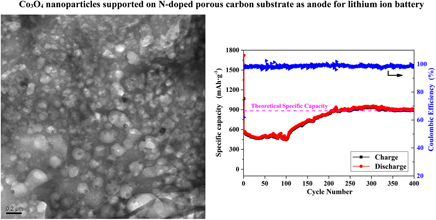Article contents
Ordered porous structure of nitrogen-self-doped carbon supporting Co3O4 nanoparticles as anode for improving cycle stability in lithium-ion batteries
Published online by Cambridge University Press: 24 August 2017
Abstract

A facile synthesis procedure of nitrogen-self-doped porous carbon (NPC) derived from abundant natural biological materials has been presented. The pyrolysis temperature and the weight ratio of Co3O4 to carbon play a key role in determining microscopic structure and electrochemical performances of the final materials. The ordered mesostructures with nanopores in the channel walls provided support for immobilization of well-dispersed Co3O4 nanoparticles. They also served as a highly conductive substrate for effectively alleviating severe particle aggregation during the charge/discharge processes, which prevented capacity fading from deteriorated electric contact between the components. Taking advantage of the interconnected porous structures and high specific surface area (1799 m2/g) of carbon substrate, the Co3O4/NPC composite as anode in lithium-ion battery delivers a stable reversible capacity of 903 mA h/g after 400 cycles. It is expected that by loading other electrode active materials on such carbon material, the manufacture of the promising anode materials with excellent cycle stability is highly possible.
- Type
- Article
- Information
- Journal of Materials Research , Volume 33 , Issue 9: Focus Issue: Porous Carbon and Carbonaceous Materials for Energy Conversion and Storage , 14 May 2018 , pp. 1226 - 1235
- Copyright
- Copyright © Materials Research Society 2017
Footnotes
Contributing Editor: Tianyu Liu
References
REFERENCES
- 12
- Cited by





